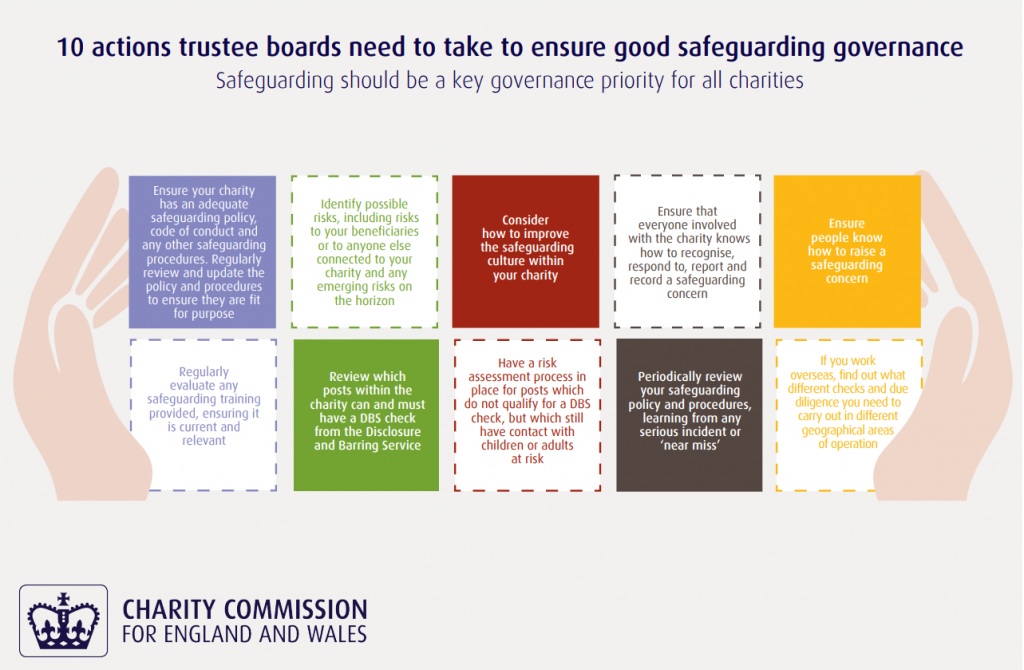Safeguarding Training for Charities

Estimated reading time: 6 minutes
Safeguarding Training for Charities: A Guide
Safeguarding is a critical aspect of any organisation, but for charities, as they often serve vulnerable people, it is especially important.
Before we go into more details, it is important to know that charities are bound by specific legislation and regulation to ensure the safety and well-being of their staff, volunteers, beneficiaries, stakeholders and communities. The responsible governing bodies are:
England – National Council for Voluntary Organisation (NCVO)
Northern Ireland – Charity Commission for Northern Ireland
Scotland – Office of the Scottish Charity Regulator (OSCR)
Wales – Wales Council for Voluntary Action (WCVA)
- Charity Commission for England and Wales provides legal guidance on various topics related to safeguarding.
In this article we will delve into the essential steps charities should take to integrate safeguarding into their operations. We also outline all the aspects that should be included in safeguarding training for charities to ensure they protect all individuals connected with their services.
Understanding the components of safeguarding training for charities
Safeguarding in charities goes beyond merely protecting individuals from harm, it includes a broad range of responsibilities. It needs to address issues such as bullying, health and safety concerns, abuse of trust and tackling “poor behavior”. For charities, safeguarding should be an intrinsic part of their ethos and culture, guiding their actions and influencing decision-making at every level. You can find more details about the Charity Commission’s safeguarding expectations for charities in this resource.
In this safeguarding for charities and trustees’ video, the Charity Commission emphasises three principles that are a critical foundation for safeguarding and a five point action plan.
Roles and responsibilities for safeguarding training for charities
The ultimate responsibility for safeguarding lies with the charity’s trustees. Often a designated safeguarding lead is appointed to oversee all safeguarding measures and respond to concerns about vulnerable individuals. If the Charity Commission has concerns about a charity’s safeguarding practices, they may refer them to relevant safeguarding agencies such as the police, local authorities or the Disclosure and Barring Service (DBS).
This infographic sets out the Commission’s ten actions that trustees must consider to ensure good safeguarding practices.
Actions to consider for safeguarding training for charities
1. Improving culture
Creating a culture that prioritises safeguarding is crucial. This involves fostering an environment where everyone understands the importance of safeguarding and feels empowered to raise concerns.
2. Policies and procedures
Charities should establish clear and comprehensive safeguarding policies and procedures. Documents should outline the charity’s commitment to safeguarding, the expected behaviours and the steps to take in case of safeguarding incidents or concerns occur. This includes having clear policies on bullying and harassment, whistleblowing and having suitable insurance in place.
3. A code of conduct
Implementing a code of conduct helps set behavioural expectations for all individuals associated with the charity. This includes staff, volunteers, trustees and anyone who interacts with the organisation. An outline of what a code of contact should include is outlined by the government.
4. Procedures for managing concerns
Establish a confidential and accessible system for reporting safeguarding concerns. It is essential to create an environment where individuals feel safe to report any incidents without fear of reprisals.
5. Up-to-date safeguarding training
Regular training on safeguarding is crucial for all staff and volunteers regarding safeguarding principles and their roles and responsibilities. Training raises awareness of safeguarding issues, the signs to watch out for and the appropriate actions to take if you have a concern.
Funding has been made available to ensure that all charities can access safeguarding training to build a safe and strong civil society.
6. Safer recruitment procedures
Implement robust recruitment practices that include background checks, reference checks and interviews to ensure the suitability of individuals working with vulnerable beneficiaries and stakeholders.
A huge part of the safer recruitment process is carrying out relevant checks which can include:
- Checking gaps in people’s work history.
- Checking references.
- Carrying out Disclosure and Barring Service (DBS) checks.
7. Risk assessments
Identify and assess potential safeguarding risks within the charity’s activities and services. You can address these risks proactively to minimise the chances of incidents occurring and also build in a continuous review plan.
8. Collaboration and networking
Safeguarding in charities does not exist in isolation. Engaging with other charities and organisations working in similar fields can provide valuable insights and best practices for safeguarding. Collaborating with the relevant agencies can also enhance the effectiveness of your safeguarding efforts.
Conclusion
Safeguarding should be at the forefront of every charity’s mission and woven into the fabric of their operations. Trustees have a responsibility to ensure that their charity has appropriate policies and procedures in place to protect everyone who they come in contact with.
By establishing strong policies, comprehensive procedures and a supportive culture, charities can protect the welfare of all individuals connected with their services. The collective efforts of trustees, designated safeguarding leads, staff, volunteers and external agencies working together, will ensure a safe environment and in turn make a positive impact on the lives of those they serve.
Safeguarding training for charities
Our comprehensive range of online and face-to-face safeguarding training ensures your staff, volunteers, and stakeholders understand safeguarding principles and best practices and can recognise and respond to potential risks and concerns proactively as well as get a step-by-step guide to ensure you understand the correct processes to report them. If you would like more help choosing the best safeguarding course for yourself or your charity, you can get in touch with our friendly customer service team by calling us on 01327 552030, emailing us at hello@smarthorizons.co.uk, or using contact form on our website.
Resources
- NSPCC range of resources on safeguarding guidance for voluntary and community organisers.
- The National Council for Voluntary Organisations (NCVO) provides a range of resources on getting started with safeguarding.
- The Charity Governance Code outlines best practice advice including safeguarding.
- UK network for organisations working in international development called Bond provides the good governance for safeguarding guide in collaboration with UK Aid.
- Charity Commission’s Safeguarding and Protecting People for Charities and Trustees.
- Charity Commission’s Strategy for Dealing with Safeguarding Issues in Charities.
- NCVO (England).
- Charity Commission Northern Ireland.
- Office of the Scottish Charity Regulator (OSCR).
- Wales Council for Voluntary Action (WCVA).
- Working Together to Safeguard Children.
- Keeping Children Safe during Community Activities, After-School Clubs and Tuition.




